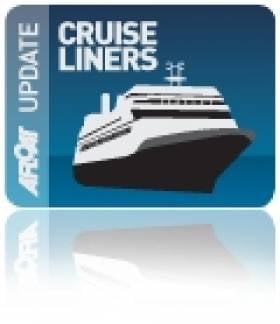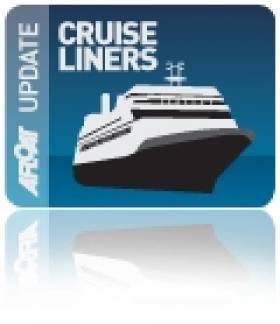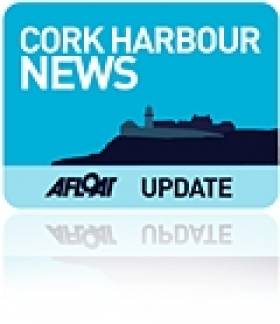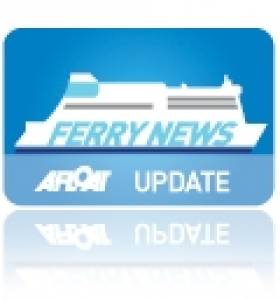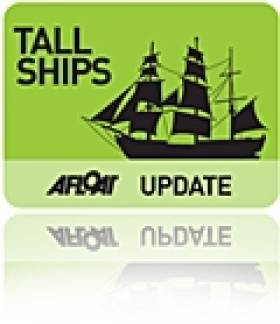Displaying items by tag: Cork Harbour News
Queen’s Namesake to Retrace Royal Visit
The 90,901 gross registered tonnes cruise ship is to depart her Hampshire homeport, where she is to similarly follow the monarch in that she is scheduled to make a port of call to Dublin first on 9 September and make a call to Cork afterwards.
With a length of 295m / 965-feet the vessel will dock in the centre of the capital port before she sails overnight to make a morning arrival at Cobh, the dedicated cruise terminal for the Port of Cork. She is scheduled to stay at the Cork Harbour town formerly named Queenstown until a 17.00 hour departure.
Her visit coincides with Cork Harbour Open Day, where visitors can view the impressive vessel from the quayside, for more details visit www.corkharbour.ie
Incidentally her near-sister Queen Victoria also called to Dublin in May and the remaining vessel of the Cunard fleet, the 'flagship' liner Queen Mary 2 is also to dock in Cobh three days later after Queen Elisabeth's visit.
- Cobh
- Cork Harbour
- port of Cork
- Cruise Liners
- Cork Harbour Open Day
- Ports and Shipping
- Cobh Cruise Terminal
- Queen Elizabeth II
- Cork Harbour News
- Port of Cork Company
- Cunard Line
- queen victoria
- Port of Cork News
- Queen Elizabeth
- Queen Mary 2
- QM2
- Cruise Liner news
- TransAtlantic Liners
- Cruise ships
- Irish cruiseship calls
- Queen's visit to Ireland
- QV
- QE
- Cunarders
- Cobh Cunarders
- Cobh cruise calls
- Cunard liners
- Cunard cruiseships
- Royal visit to Ireland
- Cobh cruise liners list
Costa 'Del' Cork
To get a better understanding of the extensive facilities available on board for the 2,826 passengers, why not have a gawk using the Multi-Media Centre page by clicking HERE (noting when done then click 'Pictures and Movies'). From here you can enter the world of life-on board (with video presentations by scrolling down) for the aromatic thermal baths, the shops gallery, the Japanese tea room, Cinema Etoiles, the Samsara Spa or have a look of an ocean view category cabin.
Of the 1,130 cabins in total, 52 have direct access to the Samsara Spa, 662 with private balcony, 106 suites with private balcony and 4 suites also have direct access to the Samsara Spa. To read more about the ship which also features a thalassotherapy, treatment rooms, sauna, turkish bath and an UVA-ray solarium click HERE.
‘Call for Events’- Cork Harbour Open Day
This year's Cork Harbour Open Day will take place on Saturday 10th September. The event aims to embrace the best of what Cork Harbour has to offer.
The Open Day seeks to raise awareness of the different free activities and events available for families in the harbour both on and off the water. If you would like to be involved in Cork Harbour Open Day or organise an event on the day, please contact Sara MacKeown Tel: (021) 4625375 or by email: [email protected]
All of the events will be promoted on the lead up to the day via PR, advertising and social media. For further information www.corkharbour.ie
Not One Not Two but Three Cruise Callers to Cork
Next in terms of tonnage is Holland America Line's near 60,000 tonnes Rotterdam, for more about the 1997 built click this LINK. The final member of the trio belongs to Saga Cruises subsidiary Spirit of Adventure cruises, the 10,000 tonnes Spirit of Adventure. For a visual virtual tour of the vessels interior facilities click HERE.
Spirit of Adventure was scheduled in late April on a 14-day 'Relics of Rome' cruise which was to include ports of call to Libya, Tunisia and Egypt but this was cancelled due to the political situation throughout North Africa.
The combined cruise calls to Cork Harbour has a potential capacity of 5,200 passengers and the mid-July arrival confirms the ports popularity which is to welcome this year a total of 54 cruiseships and over 100,000 passengers. Azura and Spirit of Adventure are to share the berth at Ringaskiddy while the Rotterdam is to berth at the dedicated cruise terminal in Cobh.
Ferry With 'Tourist Office' Celebrates 100,000th Passenger
In addition passengers travelling on the Julia can visit the newly installed tourist office where an advanced booking system will be available for all accommodation, leisure, and hospitality facilities located on both sides of the Irish Sea.
Irish and Welsh members of the West Cork Tourism Co–Operative, which established the ferry operation will staff the tourist office full-time during the summer months. The facility is unique to Irish-UK ferry services and was officially opened by the new Cork County Mayor Tim Lombard. For further information from the co-operative click www.westcork.ie and more about the other on board facilities click HERE.
With competition from summer sells on offer from rival operators on the Irish Sea, in particular on St. Georges Channel services, Fastnet Line are combating with deals to encourage higher occupancy sailings during the peak season.
The company are also preparing to accommodate Irish soccer fans in the autumn, following the success of Swansea City F.C. in gaining promotion to the Premiership.
- Cork Harbour
- port of Cork
- Fastnet Line
- M.V. Julia
- Ports and Shipping News
- CorkSwansea
- Cork Harbour News
- Julia
- Ferry news
- Swansea City F.C.
- Premiership
- Premiership League
- Irish soccer fans
- Swansea drydock
- WestCork Tourism CoOperative
- Cork County Mayor
- Cork County Mayor Tim Lombard
- Mayor Tim Lombard
- St. Georges Channel
- Irish Sea ferry news
Alliance Franҫcaise de Cork and Fondation Belém in association with the Port of Cork are pleased to announce arrival of the French tall-ship fleet, Belém, a 116-year old barque at one stage owned by the Guinness family, writes Jehan Ashmore.
During her four-day stay the pride of the French tall-ship fleet is to berth at Albert Quay, in the heart of Cork city-centre where the public can thread her timber decks on Saturday (2 July) between 11.30-17.00 hours and on Sunday (3 July) starting from 10.00 till 18.00 hours. There is an admission of €5 for adults, a concession of €3 and a family ticket costs €10.
Visitors can trace her long and varied career with an exhibit housed below decks of the historic vessel which was built in 1896 in Nantes. For nearly two decades she crossed the Atlantic transporting a diverse cargo but mostly spices, sugar and cocoa beans from her namesake port of Belém do Pará, on the north-east coast of Brazil bound for France. She would sail upriver on the River Seine to supply the cocoa beans for a Paris-based chocolate-maker.
Belem would later become under the British flag and she became the property of the Duke of Westminster, who converted her to a luxury pleasure yacht. In 1921 she was sold to the Hon. Arthur Ernest Guinness, who renamed her Fantôme II and took part in the Cowes regattas and cruised around the world between 1923 and 1924 with his family.
To read more on the vessel's other career's under several owners until her present-day role as a sail-training vessel operated by the Fondation Belém click HERE and also www.portofcork.ie
In addition to visitors boarding the Belem, the public are invited to attend free readings by the Cork poets William Wall and Thomas McCarthy. Accompanying the poets are French writers Maylis de Kerangal and Olivier Sebban for a session of Franco-Irish readings which too takes place on the Saturday evening between 18.00 -19.30 hours.
For further information contact Vytenė Laučytė, Cultural Coordinator, Alliance Franҫaise de Cork Tel: (021) 431 0677 or by email: [email protected]
All advance bookings for the visit on board the Belem are to be made at Alliance Franҫaise de Cork. Tickets are also available at the entrance to the tallship alongside Albert Quay, Cork. Last year Alliance Francaise celebrated its 50th anniversary
- Cork Harbour
- port of Cork
- Brazil
- Alliance Française
- Cork Harbour News
- Paris
- Belem
- Arthur Ernest Guinness
- Cocoa
- TallShips
- Albert Quay Cork
- Fondation Belem
- Tall Ships news
- Duke of Westminster
- Guinness
- Paris chocolate makers
- Fantome II
- William Wall
- Thomas McCarthy
- Cork poets
- French writers
- Maylis de Kerangal
- Olivier Sebban
The Empire Strikes Back
The 14,620 dwt US-based training-ship Empire State made a return call to the Port of Cork last night for a four-day stay, writes Jehan Ashmore.
At over 172m long the cruiser-sterned vessel with a port of registry of New York, moored at the Cobh Cruise Terminal which was recently visited by another US training ship, State of Maine (click HERE).
The veteran vessel now in her sixth decade of service and is the also the sixth training-ship to carry the name 'Empire State' for the State University of New York (SUNY) Maritime College.
Empire State was laid down as SS Oregon at the Newport News Shipbuilding and Drydock Company, Newport News, Virginia. She was launched in 1961 for the States Steamship Company and delivered a year later for service in the Pacific trades. For further information about the vessel's interim career before she was converted for her current role click HERE.
Despite her conversion she still presents a distinctive profile with the superstructure positioned amidships between the cargo-holds.
Prior to the Empire State's arrival the French cruiseship Le Diamant departed Cobh for an overnight passage to Dublin, where last year the Empire State made a port of call.
The next cruise-caller to Cobh is the 296-passenger Silver Cloud which is scheduled to dock on Monday evening.
- Dublin Port
- Cobh
- Cork Harbour
- port of Cork
- New York
- Silver Cloud
- Cobh Cruise Terminal
- Cruiseships
- Cork Harbour News
- State of Maine
- Port of Cork News
- Training Ship
- Empire State
- Suny Maritime College
- La Diamant
- Newport News and Shipbuilding
- Newport News
- States Steamship Company
- State University of New York
A Weekend to Explore the 'Bounty'
The Cork-berthed replica HMS Bounty, the purpose built movie prop tallship used in the 1962 MGM studies film release of 'Mutiny and the Bounty' starring Marlon Brando, will be open to visitors from tomorrow, writes Jehan Ashmore.
The famous tall ship is to open to the public between (11am-6pm) and these times also apply to the Saturday and Sunday. Tours on board the Bounty are self-guided with crew assistance. Admission charges are €10 for adults and children €5, children under four years go free.
The Bounty is berthed at Albert Quay which faces opposite the Cork City Marina on the south quays of the city-centre.
The public can explore her "tween" deck 8' foot ceilings, this made it easier for the film crew and their equipment to access.
As a result, Bounty has been hired by filmcrews for the making of 'Treasure Island', 'Yellowbeard', 'Sponge Bob, Square Pants, the Movie' and 'Pirates of the Caribbean - Dead Man's Chest'. In addition to commercial movies, Bounty has also been the stage for many documentaries.
To compare the differences between the replica and the original 18th century built 'Bounty' click HERE.
Lee Looks Ahead to All Antarès Arrival
A trio of French Naval mine-route survey craft are to sail upriver of the River Lee this Friday and are to berth in the Port of Cork at the North Custom House Quay, writes Jehan Ashmore.
The craft BRS Antarès (M 770), BRS Altaïr (M 771) and BRS Aldébaran (M 772) represent all of the three-ship Antarès-class which are based in the Breton naval base of Brest. At 28m long the rather stout-looking craft (photo) weigh some 250 tonnes displacement and have a crew of 23.
Leadship of the class BRS Antarès entered service in 1993 and was followed by the remaining pair which too were built by Chantier (Socarenam) in Boulogne-sur-Mer.
In March the BRS Altaïr accompanied the minehunter CMT Cassiopée (M642) to Dublin for a four-day visit during the St. Patrick's Day festival.
Brando’s ‘Bounty’ Bound for Bloomsday
The tallship used in the 1962 film of 'Mutiny and the Bounty' starring Hollywood screen legend Marlon Brando is to make a Bloomsday arrival to the rebel city, writes Jehan Ashmore.
H.M.S. Bounty is a replica of the ship in the famous 1789 mutiny against Captain William Bligh. The tallship is to dock at Albert Quay in Cork city-centre and will be made open to the public on Friday 17th, Saturday 18th and Sunday 19th June (daily between 11am – 6pm).
Tours on board the Bounty are self-guided with crew assistance and the admission charge is €10 for adults and children €5, children under four years go free.
In recent years the Bounty has appeared in 'Pirates of the Caribbean II' and in the Lone Wolf Production Group documentary on 'Blackbeard'. The ship also appeared in 2003 for a documentary on Captain Bligh for the History Channel, and the Sponge Bob Square Pants movie, which was released in November 2004. Also in that year the tallship was used in an episode for MTV.
For more information about the Cork visit click HERE and for the Bounty's voyages and background, visit www.tallshipbounty.org



























